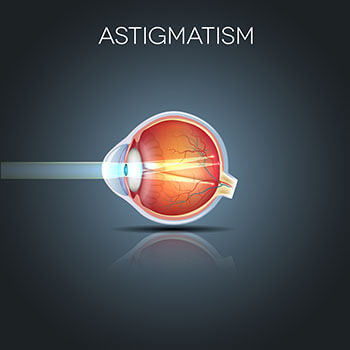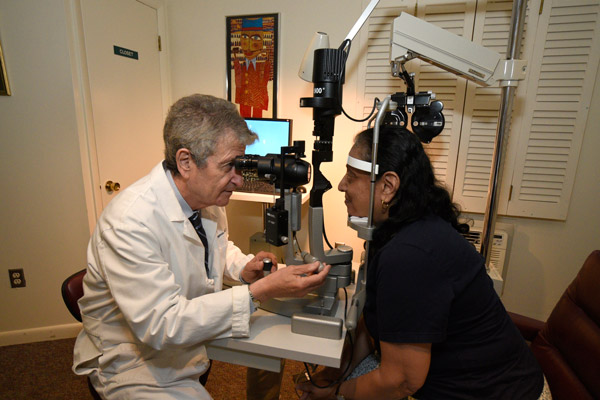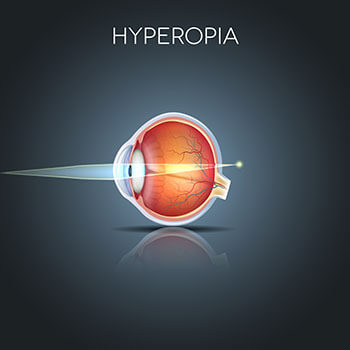Astigmatism
Throughout his career, Dr. Lippman has treated numerous patients suffering from astigmatism at his Westchester county laser eye surgery facility. Please read the information below to learn more about this common vision condition.

How Do I Know If I Have Astigmatism?
Astigmatism is a common vision condition causing blurred eyesight at all distances. Depending on the degree of astigmatism, haziness might range from hardly noticeable to pronounced blurriness. If left untreated, astigmatism might cause eyestrain and headache as the patient frequently squints to focus on objects both near and far. Some of the most common signs of astigmatism are:
- Blurred, hazy vision at all distances
- Eyestrain
- Headaches
- Frequent squinting
- Difficulty to focus while driving, playing sports, watching TV or performing other vision-intense activities
If you suspect that you might be suffering from astigmatism in Westchester County, please use our contact page to schedule a one-on-one consultation with Dr. Lippman. He will conduct a thorough set of eye examinations to diagnose your vision condition and suggest the most appropriate treatment.

How Does Astigmatism Develop?
Astigmatic patients have corneas and/or crystalline lenses that are not shaped correctly. While a normal eye can be said to be shaped like a baseball, an astigmatic eye can be said to resemble a football. The oval shape distorts proper focusing of light rays on the retina. Instead of centering on one point on the retina, light rays focus on two points at the back of the eye causing blurred vision at all distances. While astigmatism is usually hereditary, it can also develop as a result of eye injury, eye surgery and/or keratoconus (a condition whereby the cornea becomes gradually thinner and bulges forward).
How Is Astigmatism Treated?
Depending on the degree of astigmatism and patients’ preferences, it can be treated with glasses and contact lenses, refractive surgery or special implantable lenses (IOLs). As a highly experienced laser eye surgery Westchester County specialist, Dr. Lippman has helped numerous astigmatic patients throughout Westchester by providing them with customized LASIK and PRK treatments.
In addition, he also offers Acrysof Toric IOLs for cataract patients with a higher degree of astigmatism. These lens implants become a permanent part of the eye, correcting its shape and providing clear vision at all distances, often without glasses. A similarity between all of these IOLs is that they can provide clear vision without glasses for patients who do not qualify for LASIK and those undergoing cataract surgery in Westchester county.
Hyperopia
Treating Farsightedness
Dr. Lippman is a well-renowned eye surgeon in Westchester county who has helped individuals from throughout the area, at his ophthalmology practice in New Rochelle. Dr. Lippman provides LASIK, cataract surgery, and many other vision correction procedures to help Westchester county patients reduce their dependency on glasses and contact lenses. He has significant experience treating farsightedness or hyperopia in New York. Please read the information below to learn more about this vision condition.

How Do I Know If I Have Hyperopia?
Hyperopia (farsightedness) is a widespread vision problem affecting almost one-fourth of the U.S. population. Farsighted people, just like the name suggests, may see distant objects fairly well early on. However, they experience difficulty reading, sewing and performing other tasks that require good near vision. In time distance vision may often become blurred as well. Because of the stress it puts on the eyes, untreated hyperopia often causes eyestrain and/or headaches. Some of the most common symptoms of farsightedness include:
- Blurred near vision
- Eyestrain
- Headaches
- Frequent squinting when viewing objects up-close
- Unusual fatigue after reading, scrapbooking, sewing and performing other tasks requiring good near vision
If you experience one or more of these symptoms and suspect that you might be hyperopic, please use our contact page to schedule a one-on-one consultation with Dr. Lippman. He will examine your eyes and recommend the most suitable treatment.
How Does Hyperopia Develop?
Most hyperopic people are born with this condition, called “farsightedness”, although it usually does not become apparent until ones mid-forties. Irrespective of the cause, hyperopia affects vision by an inability to focus. In contrast to a normal eyeball, the hyperopic eye is shorter from front to back. While small, this deformity causes blurred distance vision by making light rays focus behind the retina rather than directly on it. Hyperopia does not improve by itself, which is why farsighted patients should seek treatment to alleviate their symptoms and improve their quality of life.
How Is Farsightedness Treated?
For many years, farsighted people had to wear glasses and/or contact lenses in order to achieve clear distance and near vision, and most still take this approach. However, today there are a range of treatment options that can effectively correct hyperopia while reducing or completely eliminating dependence on special eyewear. As one of the most highly regarded Westchester county LASIK surgeon, Dr. Lippman is proud to offer treatment for patients with moderate to high levels of farsightedness. He also specializes in PRK procedure — laser refractive surgery that delivers results similar to LASIK but does not require the creation of the corneal flap.
While laser eye surgery can help many farsighted patients, it is not suitable for patients with more greater degrees of hyperopia. Instead, for patients with hyperopia higher than +3.00 diopters Dr. Lippman recommends and performs the sophisticated clear lens exchange (CLE) procedure. During this procedure, he removes the eye’s natural lens and replaces it with an artificial lens implant (IOL), such as Crystalens, or a multifocal such as Restor. This process is similar to the surgical steps Dr. Lippman completes when performing cataract surgery at Eye Surgery Center Of Westchester county. However, the lens removed during cataract surgery is clouded, while the lens removed as part of CLE might be minimally defective, or even clear. The main purpose of the CLE procedure is to correct patient’s hyperopia and eliminate his or her dependence on glasses.
Schedule A Consultation For Farsightedness Treatment
To learn more about hyperopia and to schedule a consultation with Dr. Lippman to discuss treatment options, contact the Lippman Eyecare Center today by calling or emailing us today.
Myopia
Treating Nearsightedness In New Rochelle, Mt. Vernon & Bronxville
As a leading Westchester County LASIK and Refractive Surgeon , Dr. Lippman has extensive experience treating a myriad of vision problems, including myopia. Please read the information below to learn about this correctable vision condition, which is also known as nearsightedness.

What is Myopia?
Myopia (nearsightedness) is a very common vision problem experienced by almost one-third of the people in Westchester county as well as across the U.S. population. While nearsighted people can often see very well up-close and can perform tasks such as reading without difficulty, their distance vision is unfocused and poor. Because of myopia, driving, playing sports and participating in other activities requiring distance vision often becomes difficult.
Nearsightedness Symptoms
- Blurred distance vision
- Eyestrain
- Headaches
- Frequent squinting when viewing distant objects
- Unusual fatigue after playing sports or driving
If you experience these symptoms and suspect that you might be suffering from myopia, please use our contact page to schedule a one-on-one consultation with Dr. Lippman. During your visit, he will perform a thorough eye examination to determine which vision correction treatment is most suitable for you.
How Does Myopia Develop?
While myopia is usually hereditary, sometimes it can also be brought on by eye injury. Regardless of the cause, myopia affects vision due to the distorted shape of the eyeball. While the normal eye is shaped like a baseball, a myopic eye is slightly longer from front to back. This distortion disrupts proper focusing of light rays. Instead of focusing on the retina, light rays focus at a point in front of the retina, causing distant objects to appear blurred.
How Is Nearsightedness Treated?
For many years myopia could only be treated with glasses and/or contact lenses. Today this common condition can be effectively corrected through laser eye surgery. At Dr. Lippman’s state-of-the-art facility, nearsighted patients can choose between LASIK and PRK refractive laser treatments. The latter procedure is often selected by patients with large pupils and/or thin corneas — two factors that might disqualify them from undergoing LASIK.
While PRK is appropriate for a wider range of patients, it is not for everyone. For those patients who are not candidates for any type of refractive laser surgery but desire freedom from prescription correction, Dr. Lippman offers advanced clear lens exchange (CLE) treatment. During this procedure, he replaces patients’ natural lenses with artificial lens implants (IOLs). He has helped numerous nearsighted patients achieve clear vision by providing them with these convenient lens implants in Westchester county.
Schedule A Nearsightedness Consultation
Do you believe you have the symptoms of myopia? To learn more about myopia and the treatment options available, contact our New Rochelle, NY office to schedule a one-on-one consultation with Dr. Lippman.
